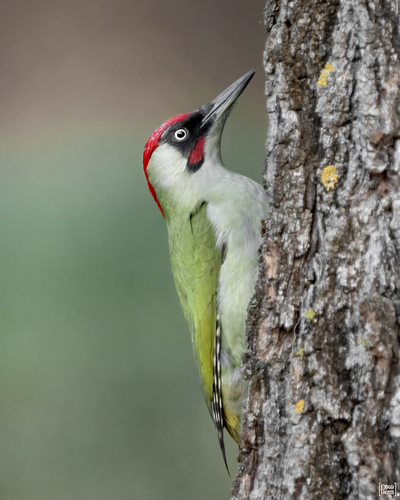
European Green Woodpecker
The European Green Woodpecker (*Picus viridis*) is a striking member of the woodpecker family, notable for its vibrant green plumage, red crown, and distinctive 'yaffle' call, which is often described as a loud, laughing sound. This species plays a significant ecological role as an insectivore, primarily feeding on ants, and contributes to forest health by controlling insect populations. It's a widespread bird across Europe and parts of western Asia, and while not globally threatened, it faces localized challenges due to habitat loss and changes in agricultural practices. It is less arboreal than other Woodpeckers.
30-36 cm
Length
40-42 cm
Wingspan
Least Concern
Conservation Status
Distribution
The European Green Woodpecker is found across most of Europe, extending eastward into western Asia, including Turkey and the Caucasus region. Its range stretches from southern Scandinavia in the north to the Mediterranean coast in the south, and from the British Isles in the west to the Ural Mountains. It is largely non-migratory, though some northern populations may move short distances south in winter.
Lifespan
The average lifespan in the wild is around 7-10 years, though some individuals may live longer.
European Green Woodpecker's Habitat
Habitat Types
Open woodlands, Parklands, Orchards, Hedgerows, Farmland with scattered trees, Large gardens
Climate Zones
Temperate, Mediterranean
Adaptations
Strong claws for gripping tree bark and a long, sticky tongue for extracting ants from crevices are key adaptations. Their stiff tail feathers provide support while climbing.
Variations
Several subspecies are recognized, differing slightly in plumage coloration and size. For example, *P. v. karelini*, found in southeastern Europe and Asia Minor, has paler underparts.
Appearance
Breeding Plumage
Plumage is generally consistent year-round.
Seasonal Feather Changes
No significant seasonal variations.
Sex Based Plumage Differences
Males have a red 'moustache' stripe, while females have a black one.
Notable Features
Bright green upperparts, Pale yellowish-green underparts, Red crown and nape, Black facial mask, Heavy, pointed bill
Diet and Feeding
Primary Foods
Ants, Ant larvae, Other insects, Occasionally fruits and seeds
Foraging Behavior
Primarily forages on the ground, probing for ants and their larvae with its long, sticky tongue. It also gleans insects from tree bark and may occasionally take fruit.
Specializations
The tongue is exceptionally long and barbed, coated in sticky saliva, allowing it to reach deep into ant nests. The skull is reinforced to withstand the impact of pecking.
Seasonal Diet Variations
Diet remains largely consistent throughout the year, though the availability of specific ant species may vary seasonally. Fruit and seeds may be taken more frequently in autumn and winter.
Behavior
Social Structure
Generally solitary or found in pairs, except during the breeding season. They are not known to form large flocks.
Communication
Distinctive 'yaffle' call (a loud, laughing sound), Drumming on trees (territorial and courtship), Various other calls and vocalizations
Migration
Mostly resident, but some northern populations may undertake short-distance movements in response to harsh winter conditions.
Territorial or Group Behaviors
Highly territorial during the breeding season, defending their nesting and feeding areas from other woodpeckers.
Conservation
Threats
Habitat loss (due to deforestation and agricultural intensification), Loss of mature trees (for nesting), Pesticide use (reducing ant populations), Changes in forestry practices
Protection Programs
General habitat protection measures, Promotion of sustainable forestry practices, Some regional conservation initiatives
Local National Laws
Protected under various national and international wildlife legislation, such as the EU Birds Directive.
Population Trend
Stable
Population Estimates
The European population is estimated to be between 1.8 and 3.2 million mature individuals.
Interesting Facts
They have a highly specialized tongue.
The tongue can extend far beyond the tip of the bill and is covered in sticky saliva and barbs to extract ants.
They are often heard before they are seen.
Their loud, laughing 'yaffle' call is a characteristic sound of woodlands and parks.
They spend a lot of time on the ground
Unlike many other woodpeckers, the European Green Woodpecker frequently forages on the ground for ants.
They can excavate large nest cavities.
The nest hole can be up to 50 cm deep.
Faqs about European Green Woodpecker
What do I do if I find an injured Green Woodpecker?
Contact a local wildlife rehabilitation center or veterinarian. Do not attempt to care for the bird yourself without expert guidance. *Consult a professional for expert advice.*
Are Green Woodpeckers harmful to trees?
While they excavate nest cavities, they typically choose trees that are already dead or decaying, so they do not usually harm healthy trees. They play a beneficial role in controlling insect populations.
How can I attract Green Woodpeckers to my garden?
Provide a suitable habitat with mature trees, areas of undisturbed ground, and avoid using pesticides. Leaving dead wood and allowing some areas to become overgrown can also help.
Do both male and female have a red crown?
Yes, both the male and the female Green Woodpecker have a red crown. The difference is in the 'moustache' stripe, red for males and black for females.
Copyright @ Nature Style Limited. All Rights Reserved.
 English
English